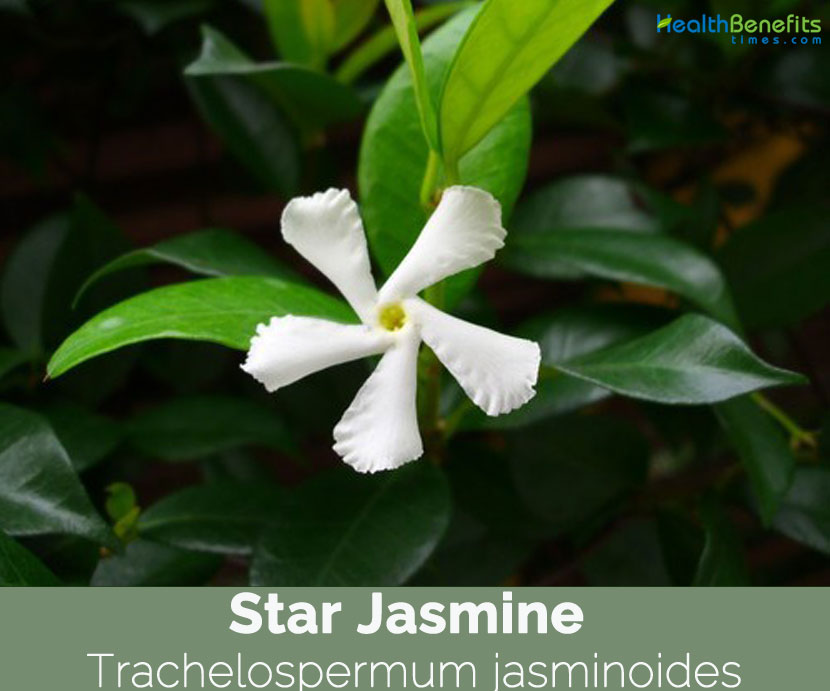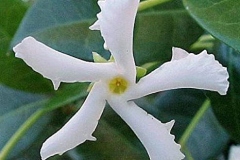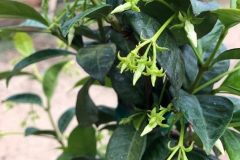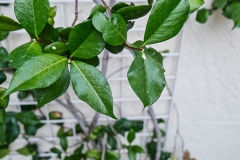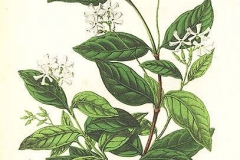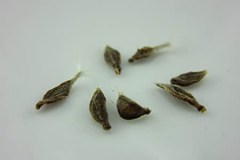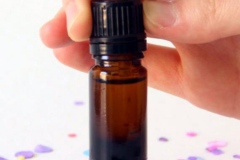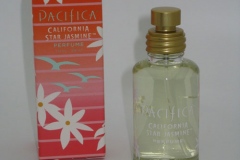| Star Jasmine Quick Facts | |
|---|---|
| Name: | Star Jasmine |
| Scientific Name: | Trachelospermum jasminoides |
| Origin | Eastern and southeastern Asia including China, Japan, Korea, and Vietnam |
| Shapes | Slender follicle 10–25 cm (3 7⁄8–9 7⁄8 in) long and 3–10 mm (1⁄8–3⁄8 in) broad |
| Taste | Bitter |
| Health benefits | Beneficial for rheumatoid arthritis, sore throats, various boils and abscesses |
| Name | Star Jasmine |
|---|---|
| Scientific Name | Trachelospermum jasminoides |
| Native | Eastern and southeastern Asia including China, Japan, Korea, and Vietnam. It has been introduced and can be found naturalized in Pakistan, India, the USA, Mexico, Central America, and the Bahamas |
| Common Names | Chinese star-jessamine, Confederate-jessamine, Confederate jasmine, Star-jasmine, Chinese Star Jasmine, Asiatic jasmine; Japanese star jasmine; small leaf confederate jasmine, Chinese ivy, Chinese jasmine, traders compass |
| Name in Other Languages | Chinese: Luo shi (絡石), Lou Shi Teng, Táiwān báihuā téng (臺灣白花藤), Shí lóng téng (石龙藤), Wànzì huā (万字花), Wànzì mòlì (万字茉莉), Shí ling (石鲮) Dutch: Italiaanse jasmijn, Toscaanse jasmijn, witte sterjasmijn English: Chinese star-jessamine, Confederate-jessamine, Confederate jasmine, Star-jasmine, Chinese Star Jasmine, Asiatic jasmine, Japanese star jasmine, small leaf confederate jasmine, Chinese ivy, Chinese jasmine, traders compass French: Faux jasmine, jasmin étoilé German: Chinesischer Sternjasmin, Sternjasmin Hindi: Kundo Italian: Falso gelsomino Japanese: Ke-teikakazura Portuguese: Falso-jasmim, jasmim-estrelado Russian: Trakhelospermum zhasminovidnyy (трахелоспермум жасминовидный) Spanish: Jazmin de leche, jazmin estrella Swedish: Stjärnjasmin Thai: Malulī (มะลุลี) USA/Hawaii: Maile haole Vietnamese: Mỏ sẻ Western Frisian: Toskaanske Jasmyn |
| Plant Growth Habit | Comparatively fast-growing, short-lived, vigorous, multi-stemmed medium-sized evergreen twining woody vine |
| Growing Climates | Found growing in sunny edges of forests, shrub lands, disturbed sites, wastelands, along roadsides, trails, gardens, parks, cemeteries, recreational sites in coastal areas, and bush tracks |
| Soil | Good humus-rich, well-drained moderately retentive soil. Succeeds in moderately acid or alkaline soils |
| Plant Size | Can reach 10 meters under optimal growing conditions in warm humid regions; but usually grows about 5 to 7m tall and 2m wide |
| Stem | Glabrous or pubescent when young, mostly branched, and with spotted lenticels on surface, glabrous when older |
| Leaf | Opposite, oval to lanceolate, 2–10 cm (3⁄4–3 7⁄8 in) long and 1–4.5 cm (3⁄8–1 3⁄4 in) broad, with an entire margin and an acuminate apex |
| Flowering season | July to August |
| Flower | Fragrant flowers are white, 1–2 cm (3⁄8–3⁄4 in) diameter, with a tube-like corolla opening out into five petal-like lobes |
| Fruit Shape & Size | Slender follicle 10–25 cm (3 7⁄8–9 7⁄8 in) long and 3–10 mm (1⁄8–3⁄8 in) broad, containing numerous seeds |
| Propagation | By seeds and vegetatively by cuttings, stem fragments and layering |
| Plant Parts Used | Whole Plant mostly Flowers, leaves |
| Seed | Oblong, 1.5-2 cm, coma 1.5-4 cm |
| Taste | Bitter |
| Season | October |
Apart from being one of popular ground cover plants, medicinally it is a very common Chinese herb that has amazing healing powder on treating stroke, arthritis, arthralgia, and other conditions associated with tendon and vessel. Because of that, it is listed in the Shen Nong Ben Cao Jing (Divine Farmer’s Materia Medica) as a top-grade herb.
Plant Description
Star jasmine is a comparatively fast-growing, short-lived, vigorous, multi-stemmed medium-sized evergreen twining woody vine that normally can reach 10 meters under optimal growing conditions in warm humid regions; but usually grows about 5 to 7 m tall and 2 m wide. The plant is found growing in sunny edges of forests, shrub lands, disturbed sites, wastelands, along roadsides, trails, gardens, parks, cemeteries, recreational sites in coastal areas, and bush tracks. The plant performs best in humus-rich, well-drained moderately retentive soil. It can also succeed in moderately acid or alkaline soils. Remarkable for its vigor, it develops long twining stems lined with persistent foliage and shiny, leathery, sometimes taking beautiful red hues. Stems are glabrous or pubescent when young, mostly branched and with spotted lenticels on surface, glabrous when older. Stems exude a milky sap when broken.
Leaves
The leaves of star jasmine are arranged opposite to each other and the petiole measures anything between 2 – 5 cm in length. The young leaves are thickly covered with greyish-brown fine hairs, which drop as the leaves mature. The leaf blade has an oval or elliptical shape. Sometimes, they are also lanceolate and measure between 2 – 8 cm in length and 1.5 – 4 cm in width. The apex of the leaves is acute or obtuse, while they are rounded or broadly cuneate around the base as well as the entire margin.
| Leaf arrangement | Opposite/sub opposite |
| Leaf type | Simple |
| Leaf margin | Entire |
| Leaf shape | Elliptic (oval) |
| Leaf venation | Pinnate |
| Leaf type and persistence | Evergreen |
| Leaf blade length | Less than 2 inches |
| Leaf color | Green |
| Fall color | No fall color change |
| Fall characteristic | Not showy |
Flowers
The inflorescence of star jasmine is axillary and measure about 5 cm in length. The plant bears white, aromatic flowers. The calyx of Trachelospermum jasminoides flowers is small and divided into five parts; the floral tube has a cylindrical shape and measures anything between 3 – 6 mm and is puberulous or minutely pubescent. Each flower has five stamens, two carpels and numerous ovules.
| Flower color | White |
| Flower characteristic | Showy; pleasant fragrance |
Fruit
The shape of the follicles is cylindrical and measures around 15 cm. The flowers bloom between July to August. The seeds of star jasmine are linear, brown and flat having a bunch of very bright and soft fur.
| Fruit shape | Pod or pod-like |
| Fruit length | 1 to 3 inches |
| Fruit cover | Dry or hard |
| Fruit color | Unknown |
| Fruit characteristic | Inconspicuous and not showy |
Traditional uses and benefits of Star Jasmine
- The leaf is restorative and tonic.
- This plant is especially useful for the aged.
- Flowering stem is analgesic, antibacterial, anti-rheumatic, antispasmodic, depurative, emmenogogue, febrifuge, resolvent, tonic and vasodilator.
- Decoction is used in the treatment of rheumatoid arthritis, sore throats and various boils and abscesses.
- The seed is cardio-tonic and hemostatic.
- Whole plant is cooked with other foods and used to treat rheumatism.
- Stem is used for the treatment of rheumatism and injury.
Other facts
- In Asia, a strong bast fiber obtained from the inner bark is used in making rope, sacks, and paper.
- Flowers yield perfumed oil.
- Star Jasmine is commonly grown as an ornamental plant and houseplant.
- It is used as a climbing vine, a groundcover, and a fragrant potted plant on terraces and patios in gardens, public landscapes and in parks.
- A valuable perfume oil is extracted from the steam distilled or tinctured flowers and used in high end perfumery.
- In a dilute form, tinctured flowers are much used in Chinese, Vietnamese and Thai incenses.
- Bast fiber is produced from the stems.
- An essential oil is obtained from the flowers.
- It uses hold fast roots to hold onto upright substrates for climbing.
- It is not a true jasmine in the genus Jasminum but gives of the fragrance of a jasmine.
Precautions
- Avoid use during pregnancy and breastfeeding.
- Avoid if you are suffering from Diarrhea.
- Consuming high doses of it may cause Convulsions and respiratory diseases.
References:
https://www.itis.gov/servlet/SingleRpt/SingleRpt?search_topic=TSN&search_value=505546#null
https://pfaf.org/user/Plant.aspx?LatinName=Trachelospermum+jasminoides
https://www.cabi.org/isc/datasheet/52837
http://www.missouribotanicalgarden.org/PlantFinder/PlantFinderDetails.aspx?kempercode=a155
https://plants.usda.gov/core/profile?symbol=TRJA
https://en.wikipedia.org/wiki/Trachelospermum_jasminoides
https://bie.ala.org.au/species/NZOR-6-125206
http://en.hortipedia.com/Trachelospermum_jasminoides
https://www.wikidata.org/wiki/Q1207043
https://www.rhs.org.uk/plants/18287/Trachelospermum-jasminoides/Details
https://npgsweb.ars-grin.gov/gringlobal/taxonomydetail.aspx?id=36784
https://gd.eppo.int/taxon/TCHJA
https://www.valdosta.edu/administration/finance-admin/plant-ops/campus-plants/confederatejasmine.php


